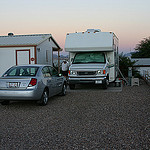How difficult is it to take an RV back to Canada?
An overview of the process required to import a vehicle to Canada

Question:
When we have nothing else to do, we often go check out the RV lots to see what is new and what is available. We were absolutely amazed at some of the deals we saw out there—good clean units at excellent prices. How difficult is it to take an RV back to Canada?
Answer:
It is so tempting, isn’t it? We have followed the same path as you. Our reason (excuse) was “we wanted to find out some of the ins and outs of buying a RV in the U.S. to import back to Canada.”
The first revelation was that even though the cost of purchasing an RV in the U.S. is very reasonable, the amount that they offer for your trade-in falls into the same category—not very much.
There are some options here: sell your RV privately and deal with the export regulations from Canada and the U.S. import regulations or take it back to Canada. Or, of course, go ahead with the trade and let the dealer worry about the paperwork.
Before a vehicle can be imported, you need to find out:
• If it is admissible. Transport Canada has a list of Vehicles Admissible from the United States—or you may need to check with the manufacturer. Unfortunately, many RV manufacturers have fallen by the wayside and are no longer in business, so the appropriate documentation is not available.
• If it has been in a collision or accident and written off by the insurance company.
• If it complies with Canada Motor Vehicle Safety Standards (CMVSS).
• If all recalls have been dealt with. The Registrar of Imported Vehicles will not release the inspection form without confirmation of corrected recalls. Again, this may be a problem if the manufacturer is no longer in business.
• If your insurance will cover your new vehicle and have it insured.
There are significant costs associated with taking a U.S. vehicle back into Canada:
• Registrar of Imported Vehicle (RIV) fees.
• Duties and taxes.
• Air conditioning excise tax.
• Excise tax (green levy) on fuel-inefficient cars.
Most of the dealers will offer to do all the paperwork for you. This comes at a price, so make sure you ask the right questions.
At the border
U.S. Customs requires three business days notice for all self-propelled vehicles leaving the country. Trailers are exempt. Make sure the U.S. Customs at the crossing you will be using has received all the necessary paperwork before you get to the border.
Canadian Border Services:
• Confirms vehicle admissibility.
• Assesses duties and taxes.
• Initiates the RIV registration process.
After vehicle entry
• A Vehicle Import Form – Form 1 has been completed and submitted to RIV through the Canada Border Services Agency (CBSA).
• The vehicle must be inspected and any necessary modifications done at an authorized Registrar of Imported Vehicles (RIV) inspection centre.
Provincial licensing
When your vehicle has passed the RIV inspection, contact your provincial or territorial licensing authority to find out how to license your vehicle.
We did find a unit that may have been made for us—BUT we considered what we have in our motorhome (solar system, arctic insulation package that keeps us warm, entertainment and extra storage unit, a place for everything and everything in its place) and what they offered and decided to stick with the devil we know.
Now, we could use an extra slide . . .








